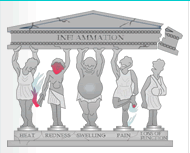How does inflammation occur? (Its mechanism)
Danger Signals
Inflammation is initiated in response to the presence of "Danger Signals". The response can be thought of as a system to exclude foreign materials and dead cells. For example, bacterial and viral infections (these are foreign substances) cause a variety of inflammatory cellular and humoral responses. These responses can be divided into two types: (1) those operated by already prepared components, that can thus work immediately, and (2) those operated by the specific components prepared after encountering foreign materials and analyzing their molecular components, that work belatedly.Recently, sensors that recognize bacterial and viral components, which do not exist in mammals such as humans, have been discovered as being important components in the initiation of the former type of reaction. The stimuli recognized by those sensors in response to the bacterial and viral components are called Danger Signals. The host-defense reaction is initiated by the sensor-acquired information relating to bacterial or viral invasion.The latter, belated responses are known as immune responses (or acquired/ adaptive immune responses). Among the components engaged in the immune responses, which are designed to exclude foreign materials, antibodies are well known. In addition, immune responses and inflammation are sometimes explained independently. However, it seems more comprehensible that disease-related immune responses be regarded as important elements of the inflammatory responses.
Danger Signals have also been identified in the internal components
Recent intensive investigation of the sensors that recognize bacterial and viral components as Danger Signals has revealed that some internal components are identified as the Danger Signals recognized by the sensors. For example, some studies have demonstrated that an effluence of some intracellular components, which exist intracellularly in normal cells, can be released after cell death and act as Danger Signals, stimulating the relevant sensors. This type of inflammation, wherein no known microbial infection is involved, is sometimes called “natural inflammation”. Because intracellular components can work as the Danger Signals, natural inflammation can easily occur and may persist. However, such an event does not occur under normal physiological conditions. It could be predicted, however, that "natural inflammation" becomes the important cause of the disease, with regard to various kinds of non-infectious chronic inflammation. The relationships between natural inflammation and the various kinds of disease with chronic inflammation remain to be completely elucidated.



